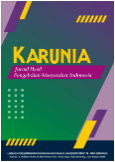Kegiatan Pengabdian Kepada Masyarakat- Skrining Penyakit Tidak Menular pada Usia Produktif di SMA ST. Yoseph, Cakung, Jakarta Timur
DOI:
https://doi.org/10.58192/karunia.v4i1.3065Keywords:
Non-communicable Diseases, Productive Age, ScreeningAbstract
Non-communicable diseases (NCDs) are a global health challenge, especially in low- and middle-income countries. Early identification of NCDs in the productive age group is very important considering the contribution of the productive age group to the national workforce and its impact on the health of future generations. This community service activity aims to increase awareness and participation in school-based non-communicable disease screening programs, especially at St. Yoseph High School, East Jakarta. The implementation of screening activities includes anthropometric examinations, blood pressure, blood sugar, and short interviews. Students with unhealthy lifestyles, such as lack of physical activity and unbalanced diets, are at high risk of developing non-communicable diseases. This activity encourages public awareness of the importance of maintaining health to prevent non-communicable diseases. This can reduce the global health burden and the economic burden for advanced disease care. Thus, this activity can improve the quality of life of the productive age population in the future.
References
Akseer, N., Mehta, S., Wigle, J., Chera, R., Brickman, Z. J., Al-Gashm, S., Sorichetti, B., Vandermorris, A., Hipgrave, D. B., Schwalbe, N., & Bhutta, Z. A. (2020). Non-communicable diseases among adolescents: current status, determinants, interventions and policies. BMC Public Health, 20(1), 1908. https://doi.org/10.1186/s12889-020-09988-5
Arifin, H., Chou, K.-R., Ibrahim, K., Fitri, S. U. R., Pradipta, R. O., Rias, Y. A., Sitorus, N., Wiratama, B. S., Setiawan, A., Setyowati, S., Kuswanto, H., Mediarti, D., Rosnani, R., Sulistini, R., & Pahria, T. (2022). Analysis of modifiable, non-modifiable, and physiological risk factors of non-communicable diseases in Indonesia: Evidence from the 2018 Indonesian basic health research. Journal of Multidisciplinary Healthcare, 15, 2203–2221. https://doi.org/10.2147/JMDH.S382191
Arora, S. (2015). Aging and non-communicable disease (pp. 1–23). https://doi.org/10.1007/978-3-319-14403-0_1
Asogwa, O. A., Boateng, D., Marzà-Florensa, A., Peters, S., Levitt, N., van Olmen, J., & Klipstein-Grobusch, K. (2022). Multimorbidity of non-communicable diseases in low-income and middle-income countries: A systematic review and meta-analysis. BMJ Open, 12(1), e049133. https://doi.org/10.1136/bmjopen-2021-049133
Asturiningtyas, I. P., Ashar, H., Purwoko, S., & Annashr, N. N. (2023). Non-communicable disease morbidity among young adults: A cross-sectional study in Indonesia. Al-Sihah: The Public Health Science Journal, 63–74. https://doi.org/10.24252/al-sihah.v15i1.33605
Az Zahra, T. I., Hambin, E. S., Novirianingtyas, T. V., Wicaksono, T. Y., Wahyuliana, L., Wardhani, A. S., Latifa, K. J. Q., Amrullah, R., Wati, P. F. Z. P. A., & Mandagi, A. M. (2022). Effective health screening strategies for overcoming non-communicable diseases in Sambimulyo Village, Banyuwangi Regency. Jurnal Pengabdian Kepada Masyarakat (Indonesian Journal of Community Engagement), 8(4), 232. https://doi.org/10.22146/jpkm.78068
Hauerslev, M., & Allen, L. (2018). Young people and noncommunicable diseases – vulnerable to disease, vital for change. International Journal of Noncommunicable Diseases, 3(2), 45. https://doi.org/10.4103/jncd.jncd_7_18
Jenim, N. (2023). The importance of early detection and screening for noncommunicable diseases. Journal of Bioengineering & Biomedical Science, 13(5), 1–2. https://doi.org/10.37421/2155-9538.2023.13.382
Jilani, U. A., Bin Othman, Z., & Jilani, S. A. (2022). Role of physical inactivity and high body mass index in the causation and primary prevention of non-communicable diseases. Malaysian Journal of Public Health Medicine, 22(1), 295–302. https://doi.org/10.37268/mjphm/vol.22/no.1/art.1516
Kementerian Kesehatan Republik Indonesia. (2016). Pedoman umum program Indonesia sehat dengan pendekatan keluarga.
Kementerian Kesehatan Republik Indonesia. (2018). Laporan nasional Riskesdas 2018 (pp. 146–379).
Suprajitno, & Mugianti, S. (2020). CERDIK behavior as a risk factor for individuals with non-communicable diseases. Systematic Reviews in Pharmacy, 11(10), 350–360. https://doi.org/10.31838/srp.2020.10.57
Widiastuti, E., Saragih, B., Fatchanuraliyah, Usman, I. K. S., Hamzah, A., Junita, T. V., Misti, Mazanova, D., Meilani, M., Samsiati, Y., Siwi, H. P., Fatihah, I. Z., Purwaningrum, D. N., Frans, S. O., Muhartini, T., & Andani, D. P. (2023). Annual report 2022 prevention and control of non-communicable diseases (NCDs).







